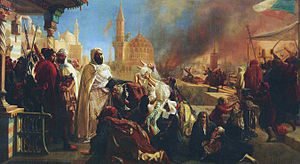1860 Lebanon conflict
| 1860 Mount Lebanon civil war | |||||||
|---|---|---|---|---|---|---|---|
 Abdelkader El Djezairi saving Christians during the Druze–Christian strife of 1860, by Jan-Baptist Huysmans |
|||||||
|
|||||||
| Belligerents | |||||||
|
Rural Druze clans
Supported by
|
||||||
| Commanders and leaders | |||||||
|
Youssef Bey Karam Tanyus Shahin Yusuf al-Shantiri Abdallah Abu Khatir Yusuf al-Mubayyad Abu Samra al-Ghanim |
Sa'id Jumblatt Khattar Imad Ali Imad † Qasim Imad Bashir Nakad Kenj Ahmad Hasan Agha al-Tawil Isma'il al-Atrash |
||||||
| Strength | |||||||
| ~50,000 (claimed) | ~12,000 (Druze) | ||||||
| Casualties and losses | |||||||
|
Mount Lebanon: 11,000 Christians and Druze fighters and civilians killed |
|||||||
Rural Druze clans
Supported by
Mount Lebanon: 11,000 Christians and Druze fighters and civilians killed
The 1860 Mount Lebanon civil war (also called the 1860 Civil War in Syria) was the culmination of a peasant uprising, which began in the north of Mount Lebanon as a rebellion of Maronite peasants against their Druze overlords and culminated in a massacre in Damascus. It soon spread to the south of the country where the rebellion changed its character, with Druze turning against the Maronite Christians. Around 20,000 Christians were killed by the Druze and 380 Christian villages and 560 churches destroyed. The Druze and Muslims also suffered heavy losses.
On 3 September 1840, Bashir Shihab III, a distant cousin of the once-powerful Emir Bashir Shihab II, was appointed emir of Mount Lebanon by Ottoman Sultan Abdülmecid I. Geographically, the Mount Lebanon Emirate corresponded with the central part of present-day Lebanon, which historically has had a Christian and Druze majority. In practice, the terms "Lebanon" and "Mount Lebanon" tend to be used interchangeably by historians until the formal establishment of the Mandate.
Bitter conflicts between Christians and Druzes, which had been simmering under Ibrahim Pasha's rule (mostly centered on the firmans of 1839 and later more decisively, of 1856, which equalized the status of Muslim and non-Muslim subjects, the former resenting the implied loss of superiority) resurfaced under the new emir. Hence, the sultan deposed Bashir III, on 13 January 1842, and appointed Umar Pasha as governor of Mount Lebanon. This appointment, however, created more problems than it solved. Representatives of the European powers proposed to the sultan that Lebanon be partitioned into Christian and Druze sections. On 7 December 1842, the sultan adopted the proposal and asked the governor of Damascus to divide the region into two districts: a northern district under a Christian deputy governor and a southern district under a Druze deputy governor. This arrangement came to be known as the "Double Qaimaqamate". Both officials were to be responsible to the governor of Sidon, who resided in Beirut. The Beirut-Damascus highway was the dividing line between the two districts.
...
Wikipedia
